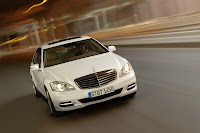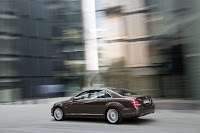Four years after the market launch of the W 221 model series, Mercedes-Benz is presenting the 2009 S-Class. Trailblazing innovations in the areas of comfort and drive engineering combined with state-of-the-art technology for enhanced safety ensure the Mercedes-Benz flagship's position as the brand's innovator and underscore its pioneering role in the automotive industry as a whole.
The engine range includes six modern petrol and diesel engines that all benefit from improved fuel consumption and lower emissions. With an average fuel consumption of 37.2 mpg, the S 350 CDI BlueEFFICIENCY is one of the most efficient models in the luxury segment. The S-Class's traditionally exemplary standard of safety is further enhanced with a unique combination of innovative camera and radar-based driver assistance systems which turn the luxury saloon into an "intelligent" partner on the road. These systems include Adaptive Highbeam Assist, Lane Keeping Assist and the advanced Night View Assist PLUS facility. Other innovations include the ATTENTION ASSIST drowsiness detection function and automatic crosswind stabilisation.
With 270,000 units sold since its market launch in autumn 2005, the W 221-series S-Class is the world's most successful luxury saloon, and seamlessly continues the success story of the flagship model in the Mercedes-Benz line-up. Since 1951, when the model 220 began the lineage of the S-Class, Mercedes-Benz has delivered around 3.3 million passenger cars from this model series to customers.
Efficient diesel and petrol engines
The range of engines for the 2009 S-Class comprises six powerful units: one diesel variant and five petrol engines with six, eight and twelve cylinders. Detailed fine-tuning of these engines has been supplemented with additional fuel economy measures as part of the BlueEFFICIENCY package. These include aerodynamic optimisation, demand-controlled fuel pumps and the fuel-efficient gearshift programme for the standard 7G-TRONIC automatic transmission. These measures have enabled Mercedes-Benz developers to improve fuel consumption and lower CO2 emissions by up to ten percent compared to the preceding models. By means of additional well-aimed aerodynamic measures, the Mercedes-Benz engineers have also managed to reduce wind noise, thus further enhancing the standard of ride comfort.
With diesel fuel consumption of 37.2 mpg and CO2 emissions of 199-201 grams per kilometre, the S 350 CDI BlueEFFICIENCY (235 hp) likewise boasts outstanding figures for the luxury class. Mercedes-Benz achieves this exemplary efficiency with a tailor-made BlueEFFICIENCY package, which also includes closed underbody panelling and decoupling of the 7G-TRONIC automatic transmission at standstill.
The range of petrol engines comprises the six-cylinder S 350 (272 hp) with a displacement of 3.5 litres and the eight-cylinder unit in the S 500 (388 hp; displacement 5.5 litres). The flagship model is still the S 600 with the 517 hp twelve-cylinder biturbo unit (displacement 5.5 litres), which accelerates the luxury saloon from 0-62 mph in 4.6 seconds. The Mercedes-AMG high-performance contributions to the range are the S 63 AMG with its 525 hp V8 engine (displacement 6.2 litres) and the S 65 AMG with a 612 hp twelve-cylinder engine (displacement 6.0 litres).
Unique combination of driver assistance systems
A world-first combination of state-of-the-art assistance and protection systems is available for the 2009 S-Class. Many of these systems are also available in the new E-Class, which will go on sale in the UK in June 2009. The new assistance systems turn the models of the E- and S-Class into "intelligent" partners for their drivers. The car is able to "see", "feel", to respond "instinctively" to detected dangers and to act "on its own initiative" in order to avoid accidents or to reduce the severity of accidents.
"Similarly to the established Mercedes inventions ABS, ESP®, Brake Assist and PRE-SAFE®, the new assistance systems are also geared to the realities of how accidents occur and what consequences they entail," observes Dr. Thomas Weber, member of the board of management at Daimler AG and responsible for corporate research and the development of Mercedes-Benz Cars. "The aim in developing these systems was to prevent particularly common and serious collisions. With this concept, the S-Class not only protects its own occupants but also plays a key role in enhancing safety for other motorists," Dr. Weber adds.
To this end, Mercedes-Benz also deploys cameras which scan the road far ahead of the vehicle, monitor the surrounding area and interpret typical critical situations. Such cameras are employed as standard on the Adaptive Highbeam Assist system, for example. This system detects vehicles with their lights on which are travelling towards or ahead of the car in which the system is fitted and controls the headlamps such as to ensure the largest possible range without dazzling other drivers.
The Sindelfingen-based engineers have also enhanced Night View Assist, which is now equipped with a special pedestrian detection function: as soon as the system detects pedestrians ahead of the car, they are highlighted on the display to make them more readily noticeable.
Lane Keeping Assist is another system that "looks ahead" for even safer driving. The system's computer is able to recognise lane markings by evaluating the contrasting images of the road surface and the markings. If the vehicle leaves the lane identified by the Assist function unintentionally, the driver is warned by short vibrations of the steering wheel. Unlike conventional systems of this kind, the Mercedes system is able to evaluate the driver's activities as well, and can reliably ascertain whether the car is leaving its lane intentionally or not. There is therefore no warning if the driver accelerates before overtaking or joining a motorway, brakes heavily or enters a bend, for example.
Drowsiness detection on the basis of more than 70 parameters
With the drowsiness detection system ATTENTION ASSIST, the 2009 S-Class has a very sensitive feel for the attention level of its driver, and warns them in good time when they become drowsy. This innovative technology continuously monitors more than 70 different parameters. Once the high-resolution steering angle sensor recognises the steering behaviour that typically indicates the onset of drowsiness, a warning signal is sounded and "ATTENTION ASSIST. Break!" appears in the instrument cluster.
Mercedes-Benz has also improved the long and medium-range radar used by Brake Assist PLUS and DISTRONIC PLUS proximity control. Both systems assist the driver during emergency braking. If the driver is distracted and fails to recognise the immediate danger of a rear-end collision, the PRE-SAFE®Brake is able to intervene and brake the vehicle independently. The new generation of the system offers even greater safety: if the driver fails to react even after receiving a visual and acoustic warning, the PRE-SAFE®Brake is able to activate the maximum braking pressure around 0.6 seconds before an accident. At this point the accident is identified by the system as being unavoidable – but the emergency braking action significantly mitigates the severity of the impact. The system therefore acts as an "electronic crumple zone", as it were.
Detailed fine-tuning has also given the 2009 S-Class better driving dynamics and agility. This is in large due to the new Direct-Steer system, where the ratio varies with the steering angle.
New: Active Body Control (ABC) compensates crosswinds
Mercedes-Benz developers have also added a crosswind stabilisation function (standard for S 600) to Active Body Control (ABC). For this purpose ABC uses the yaw rates and lateral acceleration sensors of the Electronic Stability Program ESP® to vary the wheel load distribution via the ABC spring struts, depending on the direction and intensity of the crosswind. This enables the effects of crosswinds to be compensated, or reduced to a minimum in the case of strong gusts.
The Torque Vectoring Brake provides the 2009 S-Class with added safety in critical conditions and even greater agility by specifically braking the inner rear wheel in bends so as to enable precise cornering by the saloon without compromising on driving dynamics.
State-of-the-art multimedia technology
In line with its self-assured character and its claim to be a technological trendsetter, the 2009 S-Class also sets standards where onboard infotainment is concerned. As a world first, on request Mercedes-Benz will equip its flagship model with the new SPLITVIEW technology for the COMAND control and display system centrally located in the centre console. This innovative display concept allows the driver and front passenger to view different content simultaneously on one and the same screen. While the driver uses the map-based navigation system, for example, the front passenger can be watching the latest film on DVD.
Mercedes-Benz has also extended the standard control and display system COMAND with additional functions, for example an SD memory card slot. Other new features include a modified Bluetooth® interface, which provides for a wireless link between a mobile phone and the standard onboard hands-free system, and a USB interface. These enable customers to export saved data and import them into any other S-Class. It is also possible to transfer navigation data. As an optional extra Mercedes-Benz also offers a Media Interface – a universal interface in the glove compartment for mobile audio devices such as an iPod® and USB stick (standard for S 600).
The standard COMAND system is additionally equipped with a Europe-wide navigation system whose data are stored on a 40 GB hard disc. This allows particularly fast route calculation. The high level of navigating convenience is also aided by the detailed three-dimensional city map mode.
Musical entertainment is provided by a radio, a CD/DVD player with MP3 function, an equalizer with speed-dependent volume control and the Music Register with a 7.2 GB hard disc which stores around 2500 digital music files in MP3, AAC or WMA format. The system recognises music files played on CD, DVD or from the Music Register using its stored Gracenote® database, and shows the title, album and performer in the colour display. The new Music Search function enables S-Class drivers and passengers to search SD memory cards, USB sticks, CDs and DVDs for specific music titles and performers. COMAND also includes the latest-generation LINGUATRONIC voice-operated control system, which operates the navigation, telephone and audio devices by whole-word commands. This has the advantage that the driver no longer has to spell out their commands.
Mercedes-Benz has also increased the range of rear-seat entertainment functions in the 2009 S-Class. Passengers in the rear now have a remote control unit which enables all the audio and telematics functions of COMAND to be operated, plus access to external devices via the Media Interface. Mercedes-Benz also offers a rear-seat entertainment package with two eight-inch displays on the rear surfaces of the front seat head restraints, two wireless headphones and a separate CD/DVD player with connections for external audio and video devices.
The "Logic7" surround sound system developed by Mercedes-Benz together with the audio specialists harman/kardon® delivers outstanding performance with three-dimensional sound as a natural 360-degree musical experience for all passengers.
Design: a muscular, self-assured presence
The modified design reflects the effortless superiority and power of the S-Class Saloon. It is characterised by the more pronounced arrow-shape of the radiator grille, plus a new front bumper with a discreet light-catching contour and a chrome strip below the cooling air intakes. In future the exhaust tailpipes of all S-Class variants will be visibly integrated into the rear bumper. The headlamps have bi-xenon technology as standard.
An even more dynamic look is ensured by the standard LED Light package with its striking LED arrays for daytime driving lights, indicators and marker lights. These lend an unmistakable day-and-night design to the front end. The rear end is characterised by tail lights in an innovative LED design. Here too, a total of 52 LEDs in the form of a double-C form an unmistakable light signature.
Mercedes-Benz also makes more use of light as a styling element in the interior. In future customers who specify the optional ambient lighting (standard for S 600) will have a choice between three lighting moods: solar (amber), neutral (white) and polar (ice-blue).
Images : 2009 Mercedes Benz S-Class
[Source : DAIMLER]





















ความคิดเห็น
0 Responses to "Updated! : The 2009 Mercedes-Benz S-Class"Post a Comment